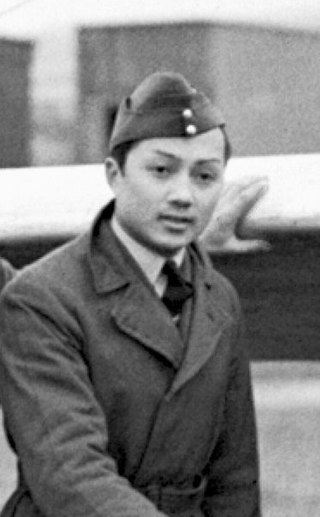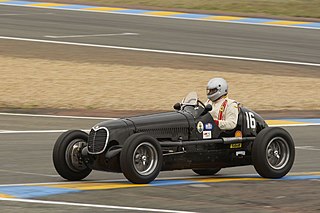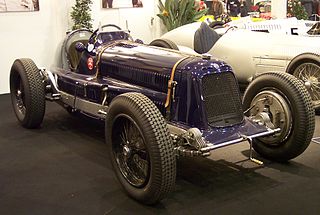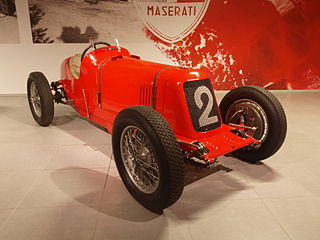
Prince Birabongse Bhanudej Bhanubandh, better known as Prince Bira of Siam or by his nom de courseB. Bira, was a member of the Thai royal family, racing driver, sailor, and pilot.

The Mercedes-Benz W196 was a Formula One racing car produced by Mercedes-Benz for the 1954 and 1955 F1 seasons. Successor to the W194, in the hands of Juan Manuel Fangio and Stirling Moss it won 9 of 12 races entered and captured the only two world championships in which it competed.

The Maserati 250F was a racing car made by Maserati of Italy used in '2.5 litre' Formula One racing between January 1954 and November 1960. Twenty-six examples were made.

The Maserati 450S is a racing car made by Italian automobile manufacturer Maserati for participating in FIA's endurance World Sportscar Championship racing. A total of nine were made.

Maserati A6 were a series of grand tourers, racing sports cars and single seaters made by Maserati of Italy between 1947 and 1956. They were named for Alfieri Maserati and for their straight-six engine.

Maserati 150S is a racing car made by Maserati of Italy alongside the Maserati 200S, to take over for the aging Maserati A6GCS racing variants. Depending on the source, between twenty-four and twenty-seven examples were built, and one additional street-going car, called the Maserati 150 GT.

The 125 F1 was Ferrari's first Formula One car. It shared its engine with the 125 S sports racer which preceded it by a year, but was developed at the same time by Enzo Ferrari, Valerio Colotti and designer, Gioacchino Colombo. Initially the racer was called 125 GPC for Gran Premio Città or Grand Prix Compressore before the Formula One era.

The Maserati Tipo 60/61 are a series of sports racing cars produced between 1959 and 1961 by Italian automobile manufacturer Maserati for privateers racing in sports car events including the 24 Hours of Le Mans in the 2-litre and 3-litre racing category. It used an intricate tubular space frame chassis, containing about 200 chro-moly steel tubes welded together, arranged triangular formation at high stress areas of the chassis, hence the nickname "Birdcage". This method of construction provided a more rigid and, at the same time, lighter chassis than other racing cars of the time.

The Maserati 6CM is an Italian single-seater racing car, made by Maserati of Modena from 1936 to 1940 for the Voiturette racing class. Twenty-seven were built on the Maserati 4CM frame, with front suspension as on the Maserati V8RI, and had a successful racing career from 1936 to 1939. The 6CM was introduced to the world at the 1936 Milan Motor Show. Maserati spent much of its early years manufacturing cars for privateers in the racing field. The Maserati 6CM is no exception.

The Maserati 8C was a Grand Prix race car built by Maserati between 1931 and 1933. The 8C was being designed by Alfieri Maserati in the early 1930s; however, he died before its completion. The chassis was that of the Maserati Tipo 26M, and it was initially fitted with a Tipo 26M engine with its cylinders bored out by 4 mm to arrive at its limit of 2.8 litres (2,812 cc) for 69 x 94 mm bore and stroke. Development of the new 3.0 L engine continued and it was constructed for racing in 1932. The car won the 1933 French Grand Prix and Sir Henry Birkin achieved third place driving it in the Tripoli Grand Prix. However, it was not very successful in other races. The car featured some of the world's earliest hydraulic brakes. The Tipo 8C 3000 was the final two-seater Grand Prix Maserati, and was succeeded in 1933 by the Maserati 8CM, M for monoposto.

The Maserati 4CL and its derived sister model the Maserati 4CLT are single-seat open-wheel Grand Prix racing cars that were designed and built by Maserati. The 4CL was introduced at the beginning of the 1939 season, as a rival to the Alfa Romeo 158 and various ERA models in the voiturette class of international Grand Prix motor racing. Although racing ceased during World War II, the 4CL was one of the front running models at the resumption of racing in the late 1940s. Experiments with two-stage supercharging and tubular chassis construction eventually led to the introduction of the revised 4CLT model in 1948. The 4CLT was steadily upgraded and updated over the following two years, resulting in the ultimate 4CLT/50 model, introduced for the inaugural year of the Formula One World Championship in 1950. In the immediate post-war period, and the first two years of the Formula One category, the 4CLT was the car of choice for many privateer entrants, leading to numerous examples being involved in most races during this period.

The Maserati 8CM is a Grand Prix race car produced by Italian manufacturer Maserati in Bologna between 1933 and 1935.

The Maserati 250S, and its derivative and version, the 250 Sport, are sports racing cars, designed, developed and built by Italian car manufacturer Maserati, between 1954 and 1957. Only two models were produced.

The Maserati Tipo 26 was a model of Grand Prix racing car and was the first car built by Italian manufacturer Maserati, for a total of 11 examples, between 1926 and 1932.

The Maserati Tipo 26B or Maserati Tipo 26B Monoposto was a racing car built by Italian manufacturer Maserati between 1927 and 1930, in a total of six examples and one additional engine.

The Maserati 150 GT was a prototype sports car produced by Maserati in 1957. Derived from the four-cylinder Maserati 150S race car, it was a singular road-going example, and was given spyder bodywork.

The Maserati 4CM is an open-wheel Grand Prix motor racing car, designed, developed and built by Italian manufacturer Maserati, in 1931.
The Maserati 8CL is an open-wheel Grand Prix motor racing car, designed, developed and built by Italian manufacturer Maserati, from 1940 through 1946. Only two models were produced.

The Maserati 8CTF is an open-wheel Grand Prix motor racing car, designed, developed and built by Italian manufacturer Maserati, from 1938 to 1939. To date, it remains the only Italian-made car to win the Indianapolis 500.

The Maserati 6C 34 is a 750 kg open-wheel Grand Prix race car, designed, developed and built by Maserati from 1934 to 1935.




















